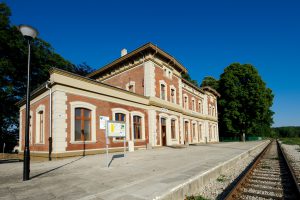Trzebnica is a city located in the distance of 24 kilometres to the north from Wrocław. The city is surrounded by the picturesque Wzgórza Trzebnickie – Kocie Góry  (the Trzebnickie Mounts – the Cat’s Mountains). The highest peaks are among others: from the east side the Winna Mount – 219 metres above the sea level, from the west side the Farna Góra – 257 metres above the sea level, from the south side the Kapliczne Wzgórze – 244 metres above the sea level. The specific charm of the landscape is created also by the orchards situated on the outskirts of the city, as well as the Las Bukowy surrounding it from its southern side. The Las Bukowy is the favourite destination for hikes and bicycle trips for both local inhabitants and guests who visit the city. There are excellent conditions here not only for enjoying peace and quiet or beauty of nature, but also for active forms of recreation. All of this is possible owing to hiking trails and bicycle routes which go through the uneven hilly terrains to charming and not well known parts of the city and the commune. The rich history of the heath resort overlaps with the modern recreational character of the city.
(the Trzebnickie Mounts – the Cat’s Mountains). The highest peaks are among others: from the east side the Winna Mount – 219 metres above the sea level, from the west side the Farna Góra – 257 metres above the sea level, from the south side the Kapliczne Wzgórze – 244 metres above the sea level. The specific charm of the landscape is created also by the orchards situated on the outskirts of the city, as well as the Las Bukowy surrounding it from its southern side. The Las Bukowy is the favourite destination for hikes and bicycle trips for both local inhabitants and guests who visit the city. There are excellent conditions here not only for enjoying peace and quiet or beauty of nature, but also for active forms of recreation. All of this is possible owing to hiking trails and bicycle routes which go through the uneven hilly terrains to charming and not well known parts of the city and the commune. The rich history of the heath resort overlaps with the modern recreational character of the city.
The crest of the city is the image of St. Peter’s head with a golden aureole situated between two crossing golden keys which are St. Peter’s attribute. The image is placed on a blue armorial bearings shield. This ornamentation motif was used in the medieval crest of Trzebnica and, since those times until the present day, it has symbolized the city.
The city has rich historic traditions. Traces of primitive man (Homo erectus), dating back from 500 thousand years ago, have been discovered in the area.
The name Trzebnica first appeared in the document from 1138. The first known owner of the Trzebnica was Piotr Włostowic.
In 1202 one of the Silesian Piast dukes, duke Henryk Brodaty (Henry the Bearded) and his wife Jadwiga founded the first in the Polish land Cistercian female monastery and a roman church. After Jadwiga’s canonisation (in 1267), it became an important centre of religious cult. In the 14th century Trzebnica (together with whole Silesia) found itself under Czech supervision, from 1526 – the Habsburg family, and from 1742 in the Prussian state. In the 17th and the 18th centuries, owing to the Polish prioresses’, the church and the monastery were rebuilt into baroque style. At that time, great Silesian artists were active in the area: M. Willmann, K. Benthum, F. Mangoldt. In 1703, Maria Karolina Leszczyńska, the future queen of France (from 1725), was born in Trzebnica.
it became an important centre of religious cult. In the 14th century Trzebnica (together with whole Silesia) found itself under Czech supervision, from 1526 – the Habsburg family, and from 1742 in the Prussian state. In the 17th and the 18th centuries, owing to the Polish prioresses’, the church and the monastery were rebuilt into baroque style. At that time, great Silesian artists were active in the area: M. Willmann, K. Benthum, F. Mangoldt. In 1703, Maria Karolina Leszczyńska, the future queen of France (from 1725), was born in Trzebnica.
In the half of the 19th century, there were springs of thermal spa waters discovered in Trzebnica and a health resort was opened. Until World War II, Trzebnica was a beautiful holiday resort. On the 25th of January 1945, the soldiers of the Red Army came to Trzebnica. The most valuable historic objects, the basilica, and the monastery, were saved thanks to the heroic attitude of the Borromaean Sisters. From the 20th of April to the beginning of June 1945 Trzebnica was the seat of the province’s administration authorities. In 1974, in Trzebnica there was created the Centre of Limb Replantation, Micro-Surgery and Arm Surgery. Trzebnica is the seat of the municipal and commune self-government, and from 1999 – also the capital of the district.





